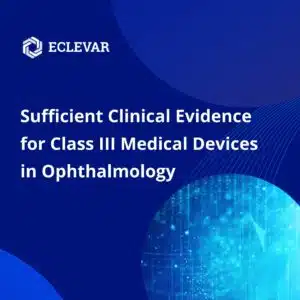In the European Union, medical devices are divided into four categories based on their intended use and level of risk. The highest risk category is Class III, which includes medical devices that are invasive, implantable, or used to sustain or support life for 30 days or more. Examples of Class III medical devices used in ophthalmology include intraocular lenses, corneal implants, glaucoma drainage devices, retinal implants, lasers for refractive surgery, and vitreoretinal surgery equipment. They require strict regulatory oversight and specialized training to ensure patient safety.
Intraocular lenses (IOLs) are medical devices used in cataract surgery to replace the cloudy natural lens with a small, artificial lens made of silicone or acrylic. They come in different types, including monofocal lenses for distance vision and multifocal or toric lenses for astigmatism correction and clear vision at different distances.
Glaucoma devices are high-risk medical devices, including implants such as glaucoma drainage devices or micro-invasive glaucoma surgery (MIGS) devices. They are designed to lower intraocular pressure (IOP) and reduce the risk of vision loss in patients with glaucoma who have not responded to other treatments. Examples of these devices include the Ahmed Glaucoma Valve, the Baerveldt Glaucoma Implant, and the iStent Trabecular Micro-Bypass Stent, which are surgically implanted in the eye to shunt excess fluid or improve drainage to reduce IOP.
Refractive lasers are high-risk medical devices used to correct refractive errors in the eye, such as nearsightedness, farsightedness, and astigmatism. They are regulated by the US FDA and the European Union’s MDU and include excimer lasers, femtosecond lasers, and microkeratome devices. These lasers are used in LASIK and PRK procedures to reshape the cornea and improve its ability to focus light on the retina. Refractive laser procedures require specialized training and expertise to ensure patient safety.
Retinal implants are devices designed to restore vision in patients with vision loss or blindness caused by damage to the retina. They work by electrically stimulating healthy cells in the retina to create visual signals sent to the brain. Several types of retinal implants are available or in development, and they can be used to treat various retinal diseases and conditions. However, they are still considered experimental and are generally used as a last resort for severe cases.
Corneal implants, called corneal inlays, are small lenses surgically implanted in the cornea to improve near vision in patients with presbyopia. They work by reshaping the cornea to improve the focus of light on the retina. Furthermore, the implants can improve near vision
by blocking unfocused light or changing the shape or curvature of the cornea. Patients should discuss the risks and benefits of corneal implants with their eye doctor before considering this procedure.
Vitreoretinal surgery equipment is specialized surgical equipment used to treat conditions affecting the retina and vitreous of the eye. It includes instruments and devices used in microsurgery, such as vitrectomy machines, retinal laser systems, retinal detachment instruments, IOLs, and endoscopic visualization systems. These tools allow surgeons to perform delicate and precise maneuvers to manage complex retinal and vitreous conditions and require specialized training to use safely and effectively.
Manufacturers of Class III medical devices in ophthalmology must comply with the European Medical Device Regulation (MDR) and provide clinical evidence to support the safety and effectiveness of their devices. Notified bodies are responsible for evaluating conformity with the MDR, and ongoing post-market surveillance is required to ensure that these devices meet high safety and performance standards.
The MDR requires that clinical data be generated from an appropriate clinical investigation, conducted following ethical and scientific standards, and based on a pre-defined clinical investigation plan. The data must be high quality, statistically sound, and relevant to the device’s intended use. For some Class III medical devices in ophthalmology, manufacturers can rely on clinical data from equivalent devices already approved for the same intended use.
The MDR, FDA, and MHRA have similar but different requirements for the clinical evidence needed to support the approval of Class III medical devices in ophthalmology. While the overall goals are identical, there are some critical differences in the types of studies required and the level of evidence necessary. The MDR generally allows for more flexibility in the types of clinical studies needed. At the same time, the FDA typically requires more extensive clinical studies, such as RCTs, and a statistically significant difference between the device and a control group. The MHRA generally follows the MDR requirements but may require well- controlled clinical studies, depending on the device and its intended use.
The MDR requires more clinical evidence for Class III medical devices in ophthalmology than the previous Medical Device Directive. The MDR emphasizes the importance of clinical data in supporting the safety and performance of medical devices, particularly high-risk devices like Class III devices. Manufacturers must also conduct ongoing post-market surveillance on their devices and implement an MDR-compliant quality management system.
However, it’s difficult for manufacturers to meet these new requirements, especially for smaller ones needing more resources. Generating clinical evidence can take a long time and
be expensive, which can hold up getting new devices out to people who need them. Also, more than the current rules might be required to show how safe and effective Class III medical devices in ophthalmology are over the long term. The MDR only requires clinical studies for up to two years (as per Article 61), and that may need more time to see how these devices work or cause problems. Finally, clinical studies might not show how well these devices work for everyone who might need them because they only include people who meet specific criteria.
Extensive clinical trials are usually required to assess the safety and efficacy of pharmaceutical drugs. These trials follow a well-defined development plan that includes several testing phases to demonstrate that the drug is safe and effective for its intended use and provides a clinical benefit to patients. On the other hand, medical devices necessitate clinical studies such as observational, single-arm, or well-controlled clinical trials, depending on the device and its intended use. Then, clinical trial requirements may be less stringent than those for drugs, and the number of participants may be smaller. Furthermore, clinical trial requirements can vary depending on the type of device and its intended application. These studies aim to generate clinical data demonstrating the device’s safety and performance and bolstering its approval.
Another significant distinction in the European Union between pharmaceutical drugs and medical devices is the regulatory approval process. Pharmaceutical drugs are regulated centralized by the European Medicines Agency (EMA), whereas medical devices are controlled by individual member states or designated notified bodies. This means clinical evidence requirements and regulatory pathways for drugs and medical devices may differ depending on the regulatory framework.
The clinical outcomes needed to demonstrate the safety and effectiveness of Class III medical devices in ophthalmology will vary depending on the device and its intended use. Regulatory authorities like the European Medicines Agency (EMA) and the U.S. Food and Drug Administration (FDA) generally require that manufacturers of these devices show clinical outcomes that support their safety and effectiveness. Some examples of clinical outcomes that may be required for specific devices include:
Improved vision: This is a common clinical outcome for devices like intraocular lenses (IOLs) or refractive surgery devices that help patients with vision problems like cataracts.
Reduced symptoms: Some devices used to treat dry eye or other ocular surface disorders may need to show a reduction in symptoms such as pain, discomfort, or dryness.
Restored function: Devices designed to restore function to the eye, like those used for retinal conditions or glaucoma, may need to show improvements in function (i.e., lower intraocular pressure or improved macular perimetry).
Long-term safety and effectiveness: To ensure that the device continues to perform as intended over the long term, regulatory authorities may require manufacturers to show that the device remains safe and effective for several years or more.
Obtaining regulatory approval for Class III medical devices in ophthalmology in the European Union is a complex process requiring clinical evidence to demonstrate that the devices are safe and effective. The European Medical Device Regulation (MDR) emphasizes clinical data, monitoring devices after they’re on the market, and ensuring manufacturers have quality management systems for high-risk devices like Class III ones. However, manufacturers face challenges, such as needing more time or resources to collect long-term safety and performance data. Despite these obstacles, manufacturers must collaborate closely with regulatory authorities to ensure their devices meet clinical outcomes requirements and benefit patients.
Prepared by:
Dr Marko Lukic, PhD FEBO FASRS Consultant Ophthalmologist

